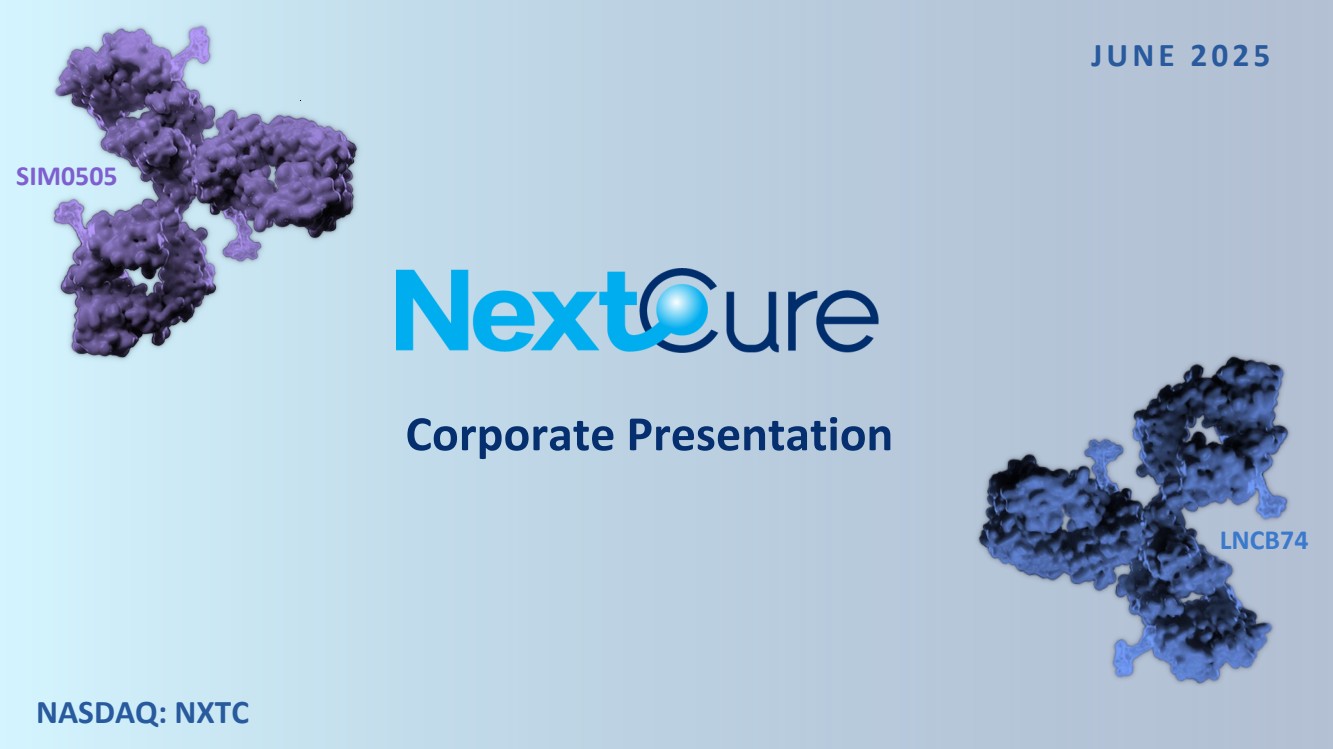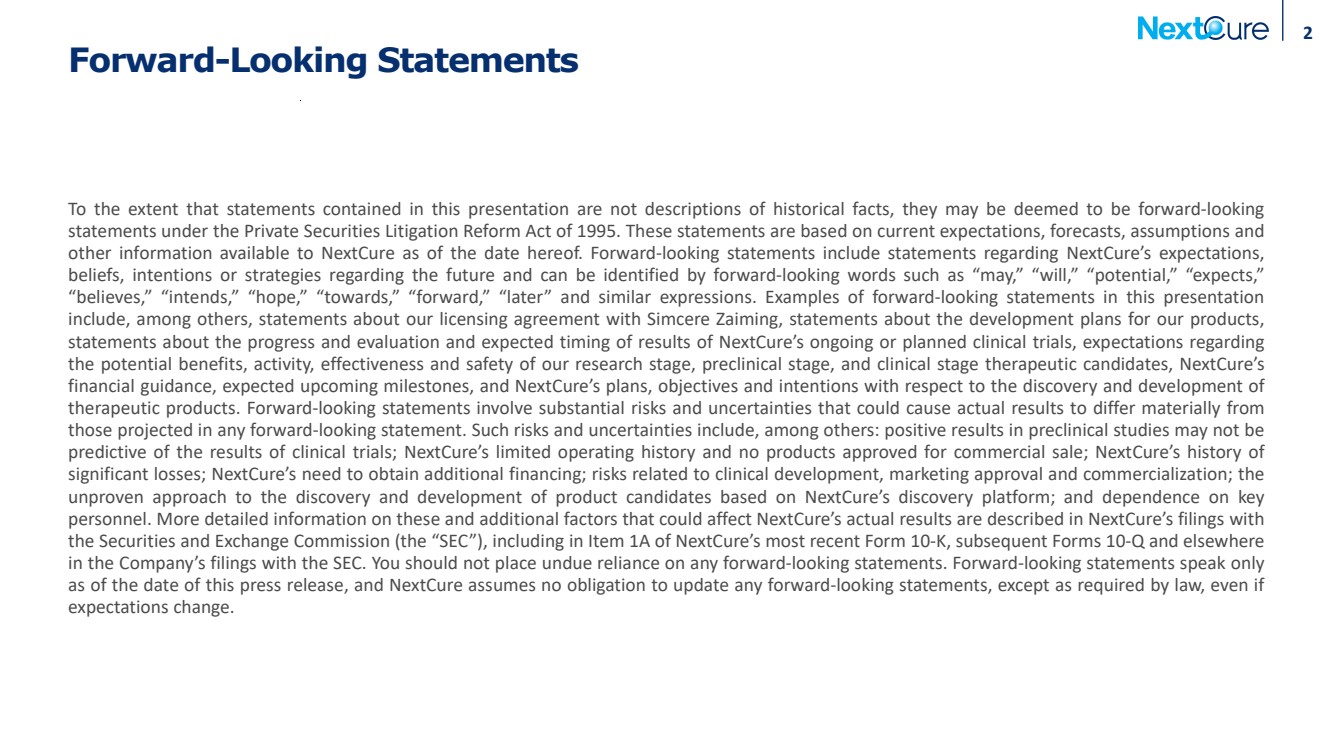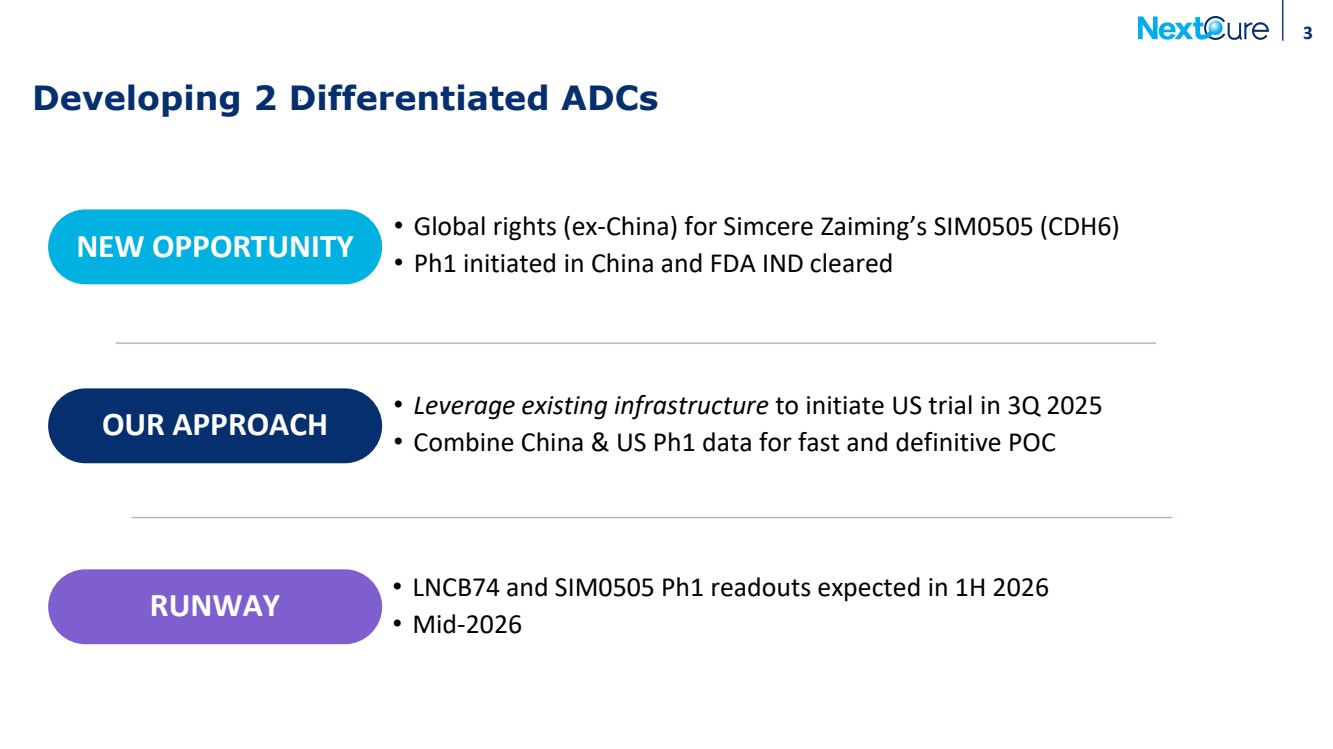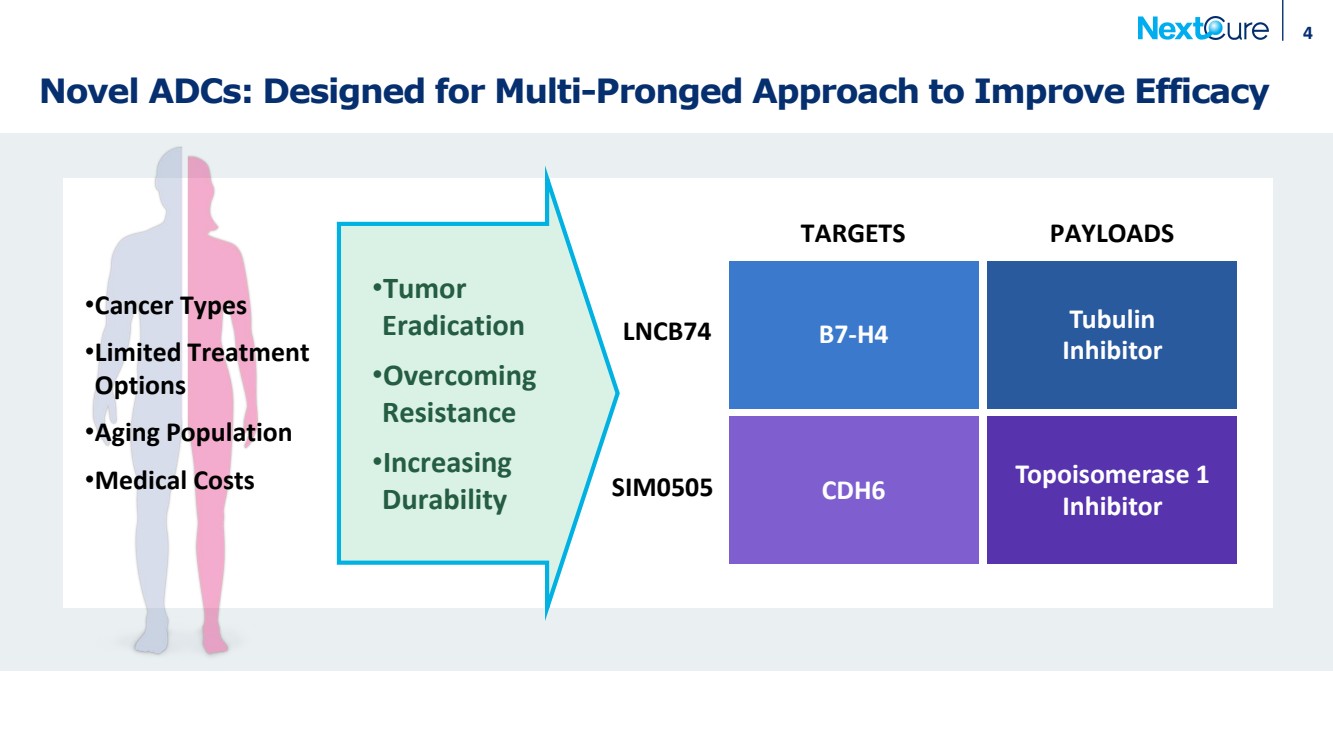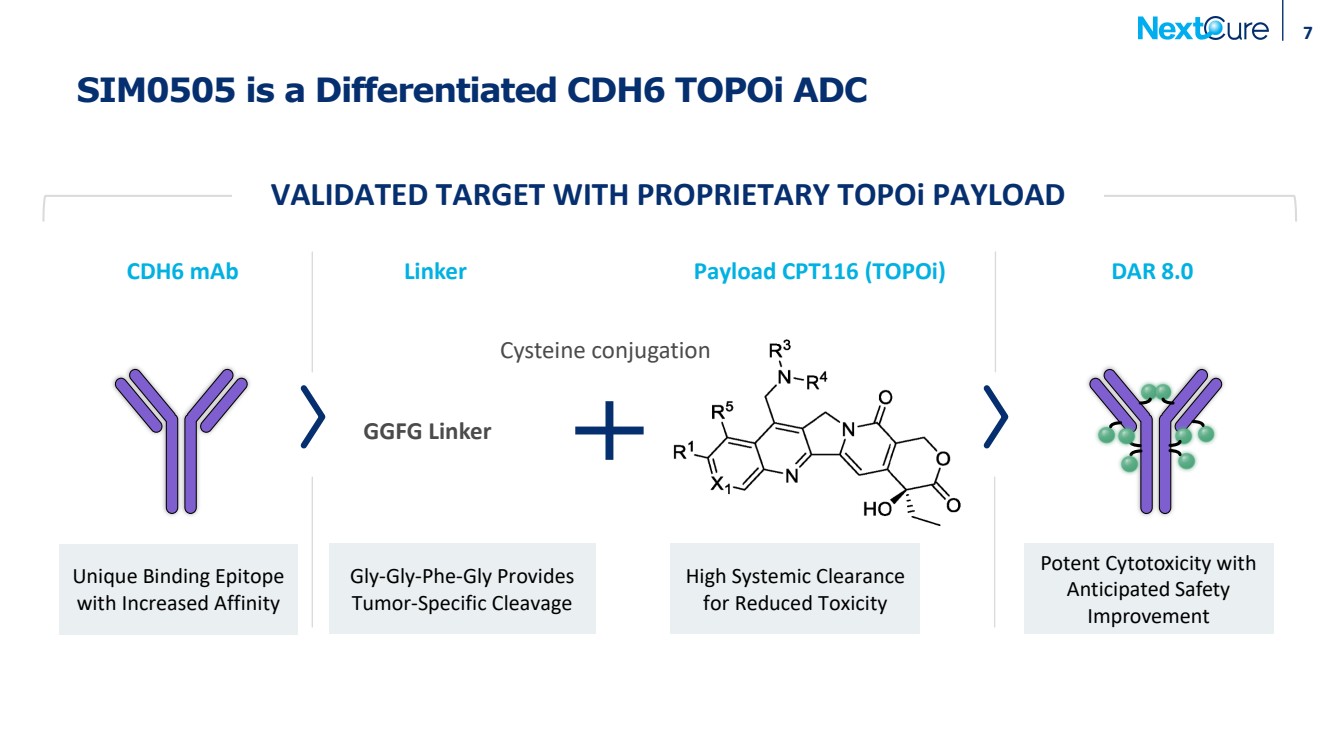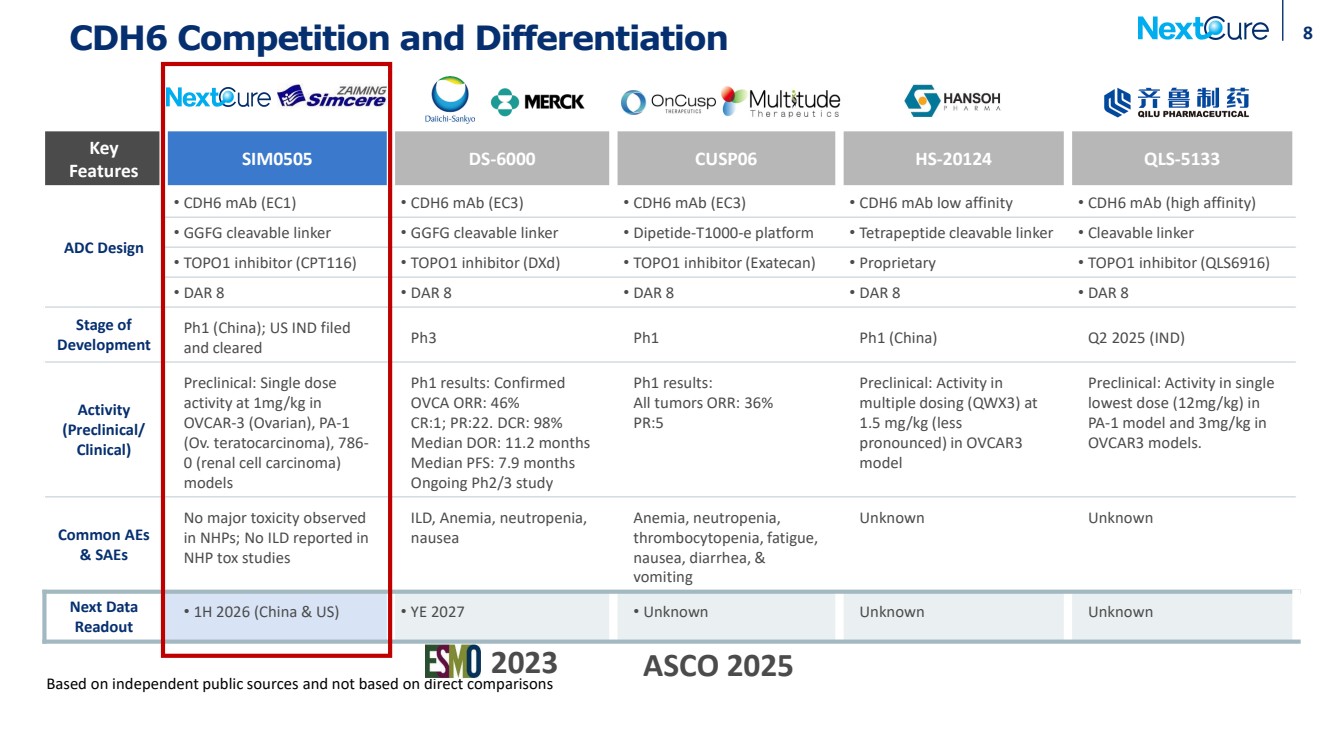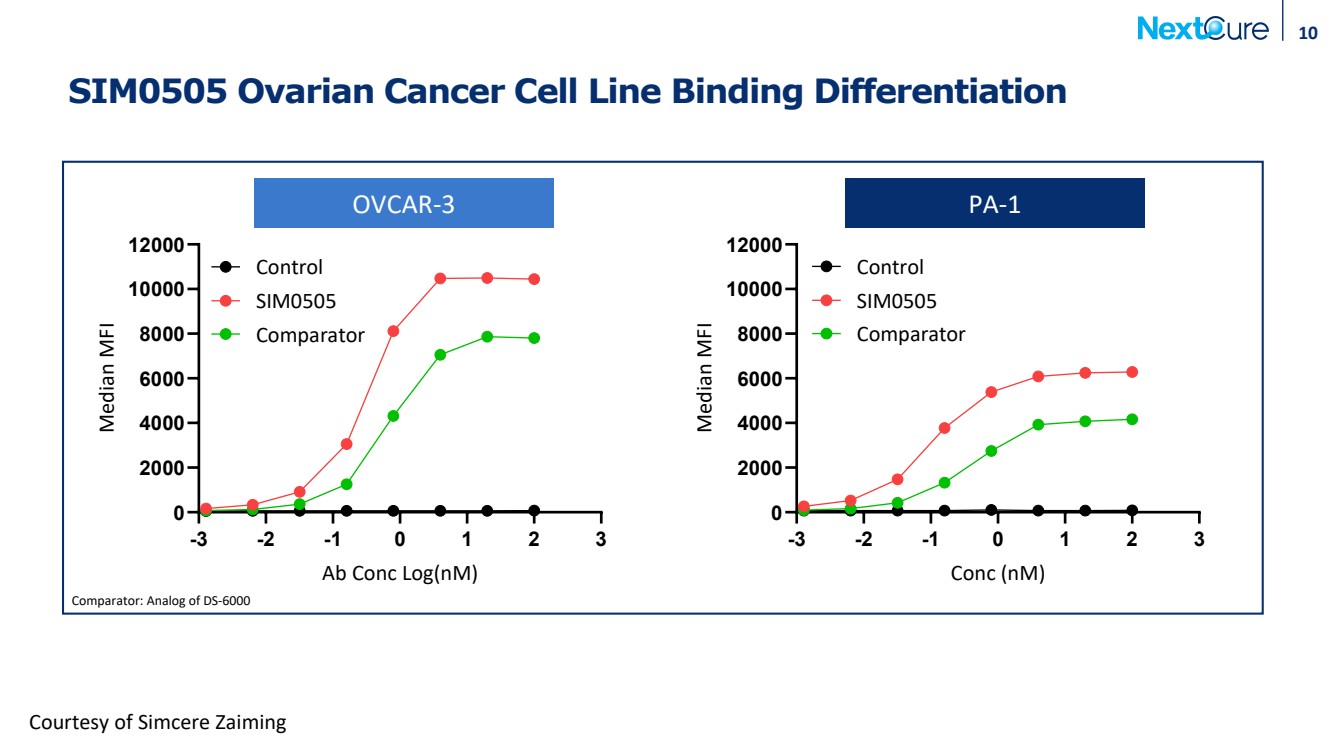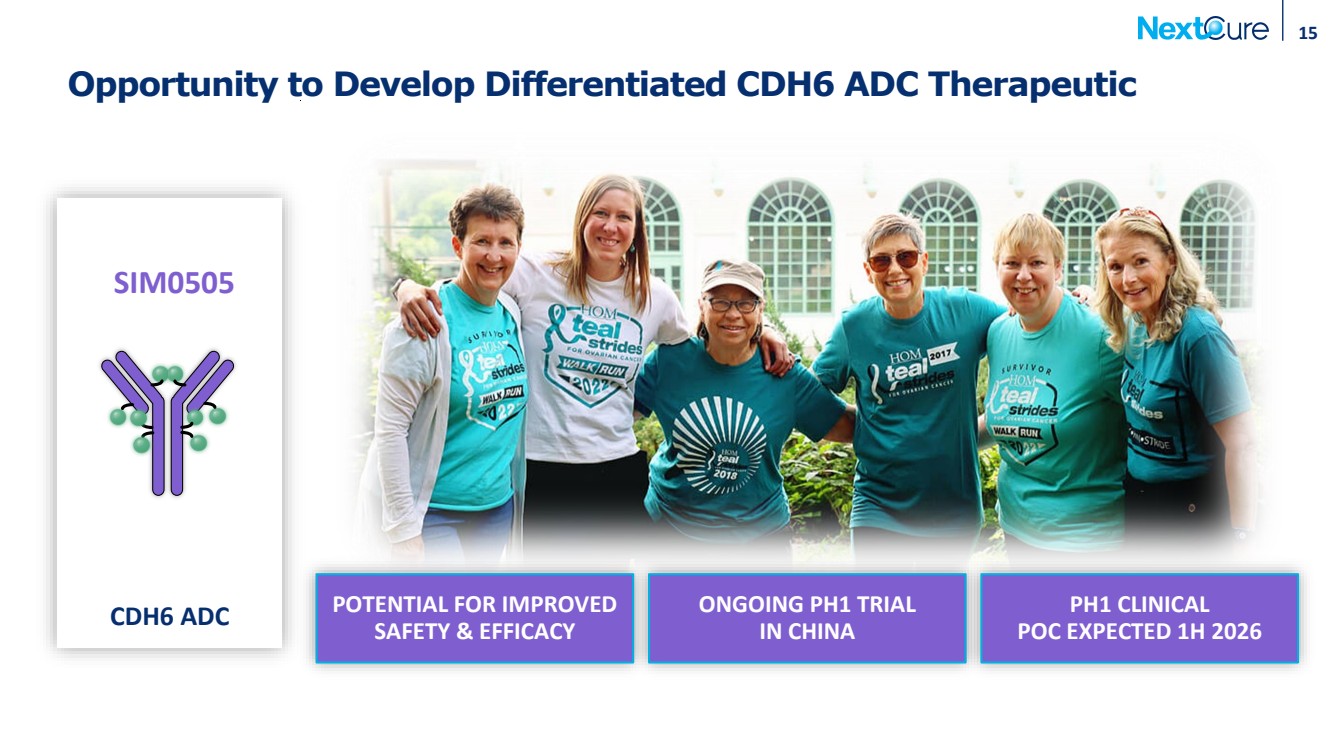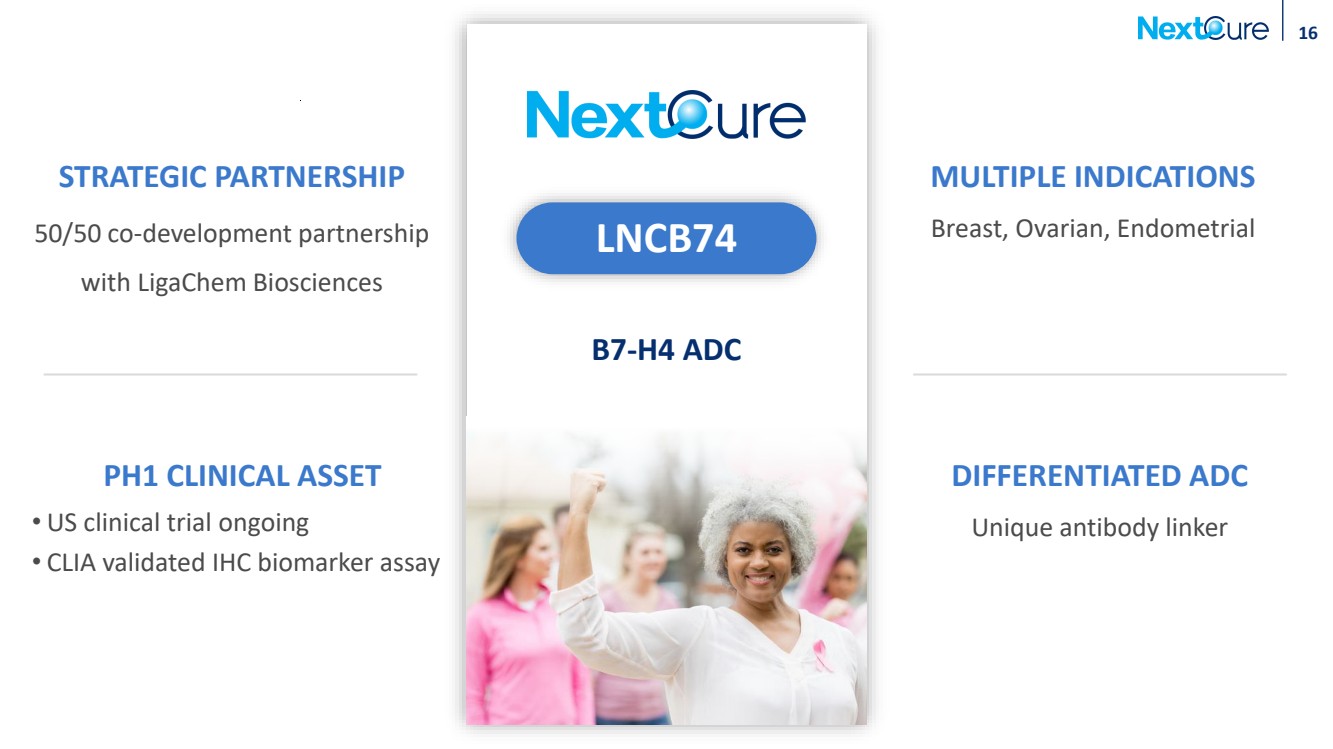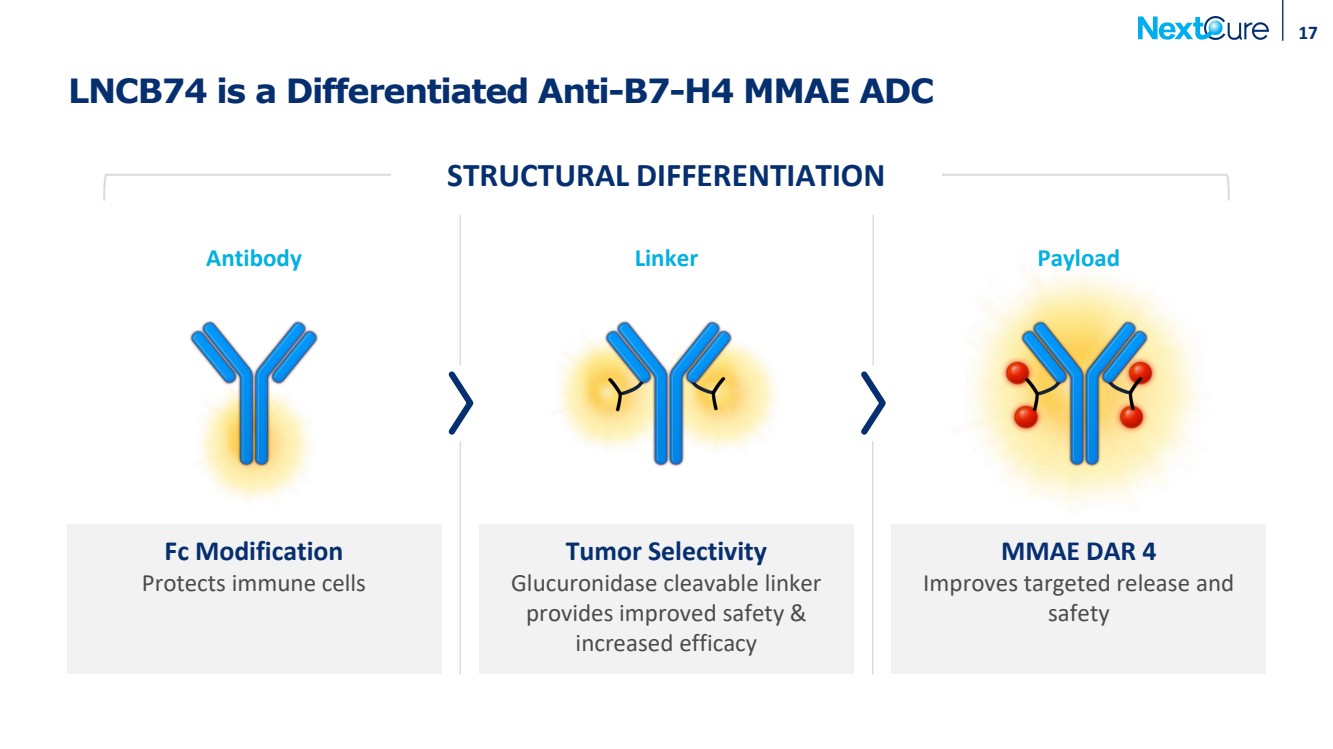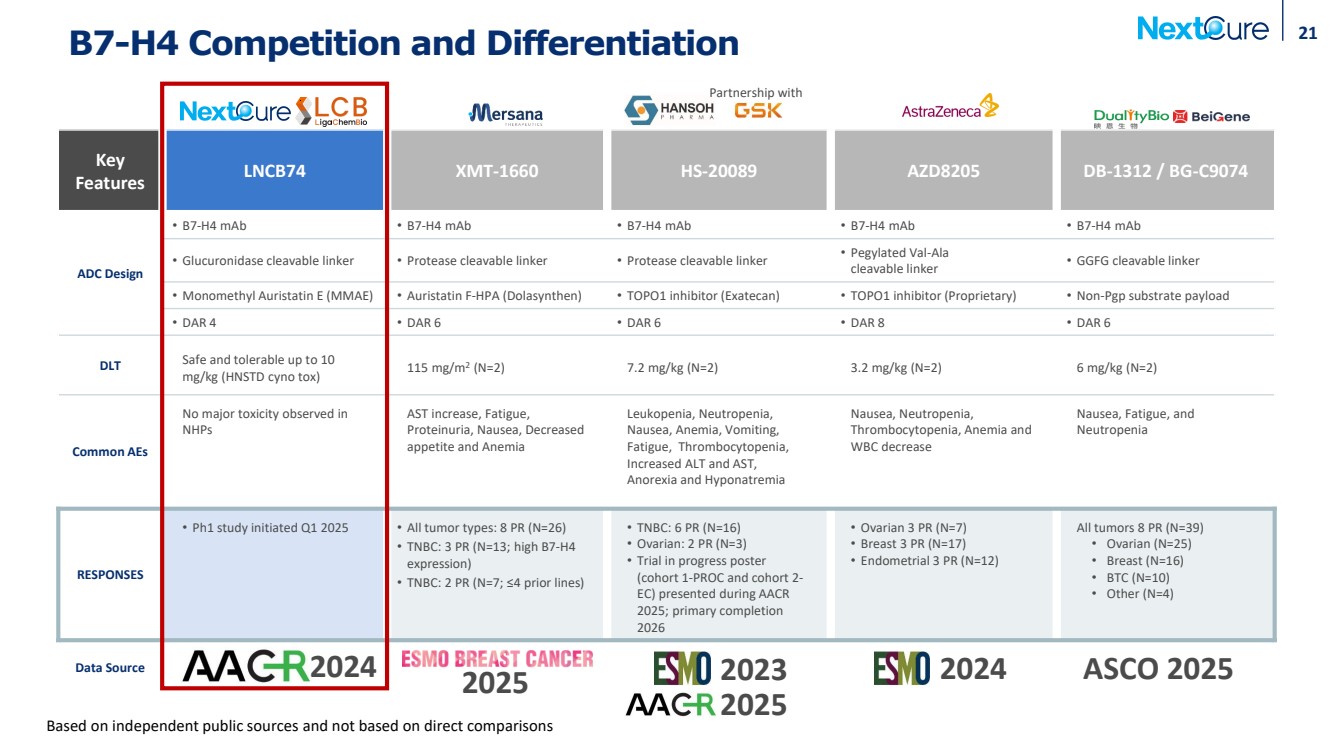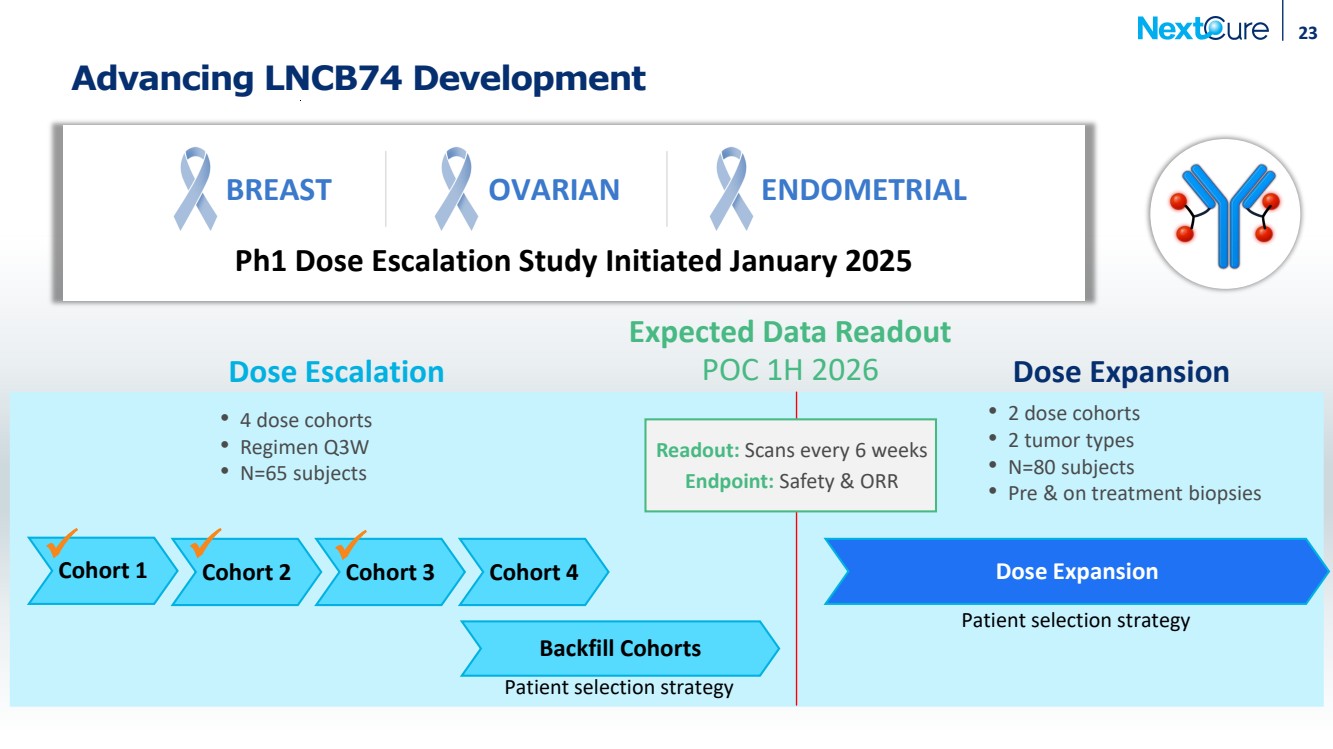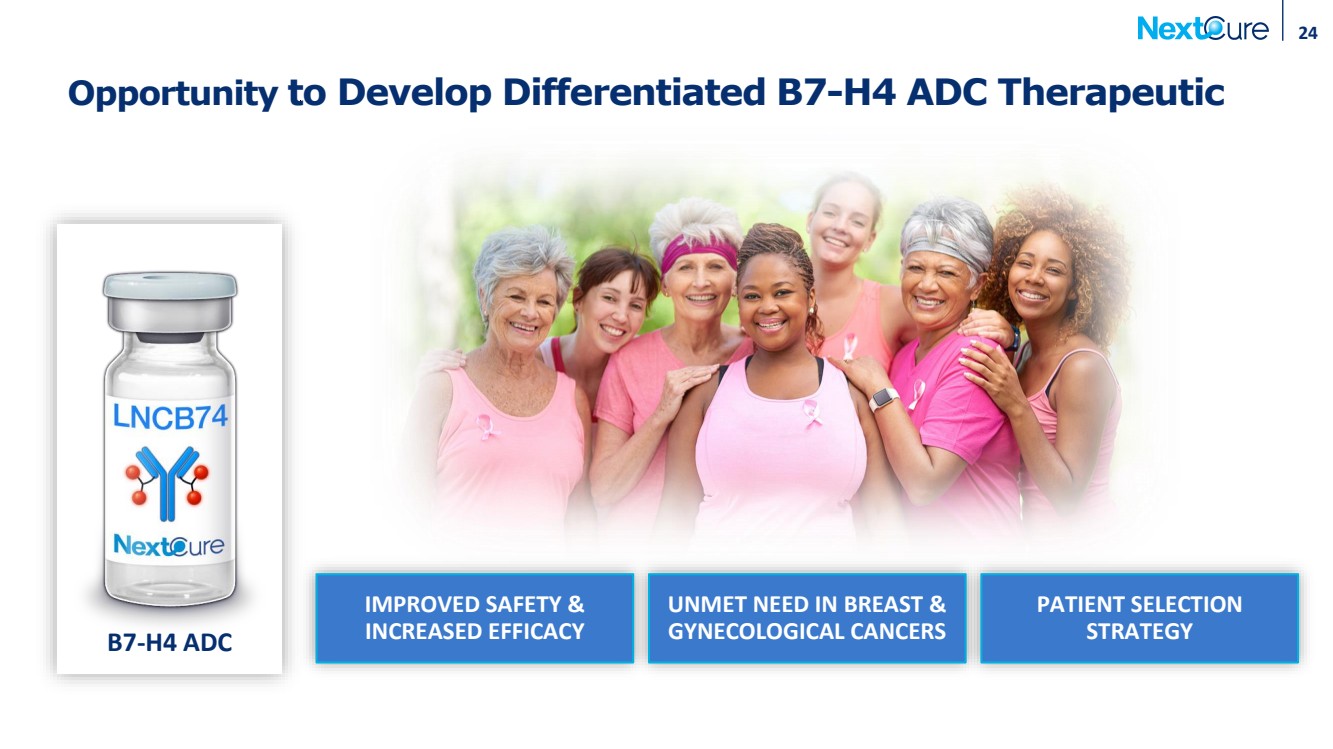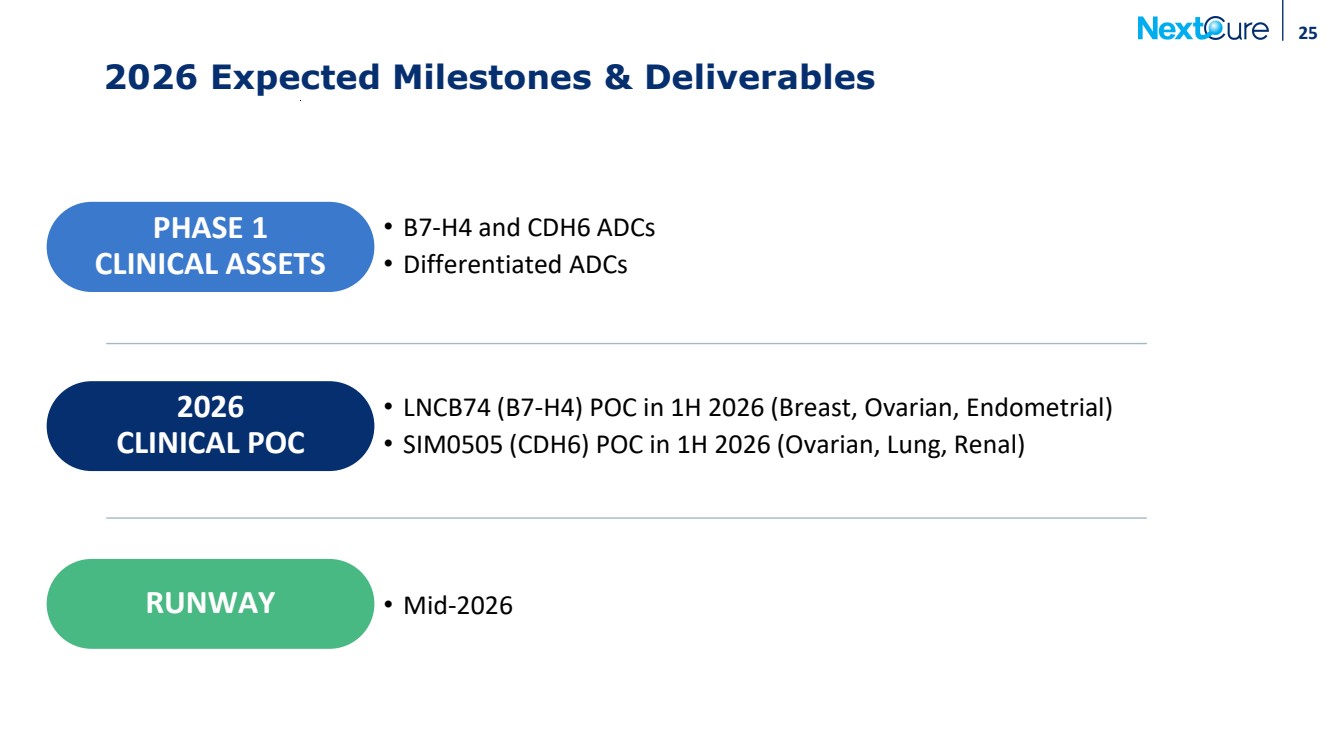| NASDAQ: NXTC SIM0505 LNCB74 J U N E 2 0 2 5 Corporate Presentation |
| Forward-Looking Statements 2 To the extent that statements contained in this presentation are not descriptions of historical facts, they may be deemed to be forward-looking statements under the Private Securities Litigation Reform Act of 1995. These statements are based on current expectations, forecasts, assumptions and other information available to NextCure as of the date hereof. Forward-looking statements include statements regarding NextCure’s expectations, beliefs, intentions or strategies regarding the future and can be identified by forward-looking words such as “may,” “will,” “potential,” “expects,” “believes,” “intends,” “hope,” “towards,” “forward,” “later” and similar expressions. Examples of forward-looking statements in this presentation include, among others, statements about our licensing agreement with Simcere Zaiming, statements about the development plans for our products, statements about the progress and evaluation and expected timing of results of NextCure’s ongoing or planned clinical trials, expectations regarding the potential benefits, activity, effectiveness and safety of our research stage, preclinical stage, and clinical stage therapeutic candidates, NextCure’s financial guidance, expected upcoming milestones, and NextCure’s plans, objectives and intentions with respect to the discovery and development of therapeutic products. Forward-looking statements involve substantial risks and uncertainties that could cause actual results to differ materially from those projected in any forward-looking statement. Such risks and uncertainties include, among others: positive results in preclinical studies may not be predictive of the results of clinical trials; NextCure’s limited operating history and no products approved for commercial sale; NextCure’s history of significant losses; NextCure’s need to obtain additional financing; risks related to clinical development, marketing approval and commercialization; the unproven approach to the discovery and development of product candidates based on NextCure’s discovery platform; and dependence on key personnel. More detailed information on these and additional factors that could affect NextCure’s actual results are described in NextCure’s filings with the Securities and Exchange Commission (the “SEC”), including in Item 1A of NextCure’s most recent Form 10-K, subsequent Forms 10-Q and elsewhere in the Company’s filings with the SEC. You should not place undue reliance on any forward-looking statements. Forward-looking statements speak only as of the date of this press release, and NextCure assumes no obligation to update any forward-looking statements, except as required by law, even if expectations change. |
| 3 Developing 2 Differentiated ADCs RUNWAY • LNCB74 and SIM0505 Ph1 readouts expected in 1H 2026 • Mid-2026 • Leverage existing infrastructure to initiate US trial in 3Q 2025 • Combine China & US Ph1 data for fast and definitive POC OUR APPROACH NEW OPPORTUNITY • Global rights (ex-China) for Simcere Zaiming’s SIM0505 (CDH6) • Ph1 initiated in China and FDA IND cleared |
| Novel ADCs: Designed for Multi-Pronged Approach to Improve Efficacy 4 TARGETS PAYLOADS B7-H4 Tubulin Inhibitor LNCB74 CDH6 Topoisomerase 1 Inhibitor SIM0505 •Tumor Eradication •Overcoming Resistance •Increasing Durability •Cancer Types •Limited Treatment Options •Aging Population •Medical Costs |
| Ongoing Ph1 Trials with Differentiated ADCs 5 PROGRAMS TARGET PAYLOAD PRECLINICAL PHASE 1 LNCB74 B7-H4 MMAE SIM0505 CDH6 TOPOi Co-development with Breast, Ovarian, Endometrial Ovarian, Lung, Renal |
| 6 STRATEGIC PARTNERSHIP Global license (ex China) from Simcere Zaiming DIFFERENTIATED ADC • Proprietary CPT116 TOPOi • Unique epitope & high affinity PH1 CLINICAL ASSET • Clinical trial ongoing in China • NXTC to initiate US Ph1 3Q 2025 • Combine US and China data for speed to POC MULTIPLE INDICATIONS Ovarian, Lung & Renal CDH6 ADC SIM0505 |
| SIM0505 is a Differentiated CDH6 TOPOi ADC 7 Payload CPT116 (TOPOi) GGFG Linker CDH6 mAb DAR 8.0 Cysteine conjugation Gly-Gly-Phe-Gly Provides Tumor-Specific Cleavage Unique Binding Epitope with Increased Affinity High Systemic Clearance for Reduced Toxicity Linker Potent Cytotoxicity with Anticipated Safety Improvement VALIDATED TARGET WITH PROPRIETARY TOPOi PAYLOAD |
| CDH6 Competition and Differentiation 8 Key Features SIM0505 DS-6000 CUSP06 HS-20124 QLS-5133 ADC Design • CDH6 mAb (EC1) • CDH6 mAb (EC3) • CDH6 mAb (EC3) • CDH6 mAb low affinity • CDH6 mAb (high affinity) • GGFG cleavable linker • GGFG cleavable linker • Dipetide-T1000-e platform • Tetrapeptide cleavable linker • Cleavable linker • TOPO1 inhibitor (CPT116) • TOPO1 inhibitor (DXd) • TOPO1 inhibitor (Exatecan) • Proprietary • TOPO1 inhibitor (QLS6916) • DAR 8 • DAR 8 • DAR 8 • DAR 8 • DAR 8 Stage of Development Ph1 (China); US IND filed and cleared Ph3 Ph1 Ph1 (China) Q2 2025 (IND) Activity (Preclinical/ Clinical) Preclinical: Single dose activity at 1mg/kg in OVCAR-3 (Ovarian), PA-1 (Ov. teratocarcinoma), 786- 0 (renal cell carcinoma) models Ph1 results: Confirmed OVCA ORR: 46% CR:1; PR:22. DCR: 98% Median DOR: 11.2 months Median PFS: 7.9 months Ongoing Ph2/3 study Ph1 results: All tumors ORR: 36% PR:5 Preclinical: Activity in multiple dosing (QWX3) at 1.5 mg/kg (less pronounced) in OVCAR3 model Preclinical: Activity in single lowest dose (12mg/kg) in PA-1 model and 3mg/kg in OVCAR3 models. Common AEs & SAEs No major toxicity observed in NHPs; No ILD reported in NHP tox studies ILD, Anemia, neutropenia, nausea Anemia, neutropenia, thrombocytopenia, fatigue, nausea, diarrhea, & vomiting Unknown Unknown Next Data Readout • 1H 2026 (China & US) • YE 2027 • Unknown Unknown Unknown Based on independent public sources and not based on direct comparisons 2023 ASCO 2025 |
| SIM0505 Antibody Binding Differentiation 9 mAb Human CDH6 Cyno CDH6 Rat CDH6 Mouse CDH6 mAb003-H2L3 0.028 0.029 0.025 0.026 DS-H01L02 0.454 0.148 No binding No binding EC50 (nM) mAb003-H2L3: SIM0505 mAb intermediate Comparator: Analog of DS-H01L02 (DS-6000 mAb intermediate) -5 -4 -3 -2 -1 0 1 2 3 0 1 2 3 4 Human CDH6-His Ab Conc Log(nM) OD450 mAb003-H2L3 Comparator Control -5 -4 -3 -2 -1 0 1 2 3 0 1 2 3 4 Rat CDH6-His Ab Conc Log(nM) OD450 mAb003-H2L3 Comparator Control -5 -4 -3 -2 -1 0 1 2 3 0 1 2 3 4 Mouse CDH6-His Ab Conc Log(nM) OD450 mAb003-H2L3 Comparator Control -5 -4 -3 -2 -1 0 1 2 3 0 1 2 3 4 Cyno CDH6-His Ab Conc Log(nM) OD450 mAb003-H2L3 Comparator Control Courtesy of Simcere Zaiming Human CDH6-His Cyno CDH6-His Rat CDH6-His Mouse CDH6-His |
| SIM0505 Ovarian Cancer Cell Line Binding Differentiation 10 -3 -2 -1 0 1 2 3 0 2000 4000 6000 8000 10000 12000 OVCAR3 Ab Conc Log(nM) Median MFI SIM0505 Comparator Control -3 -2 -1 0 1 2 3 0 2000 4000 6000 8000 10000 12000 PA-1 Conc (nM) Median MFI SIM0505 Comparator Control Courtesy of Simcere Zaiming Comparator: Analog of DS-6000 OVCAR-3 PA-1 |
| SIM0505 Active in Ovarian and Renal Tumor Models 11 0 5 8 12 16 19 22 27 0 200 400 600 800 1000 OVCAR3 CDX Days after treatment Tumor volume (mm 3 ) No Treatment SIM0505 (3 mg/kg) Comparator (3 mg/kg) 0 4 8 11 15 18 22 25 0 200 400 600 800 1000 PA-1 CDX Days after treatment Tumor volume (mm 3 ) No Treatment SIM0505 (3 mg/kg) Comparator (3 mg/kg) 0 3 8 11 14 17 21 24 28 0 200 400 600 800 1000 786-O CDX Days after treatment Tumor volume m( m 3 ) No Treatment SIM0505 (10 mg/kg) Comparator (10 mg/kg) OVARIAN (OVCAR-3) CDX OVARIAN (PA-1) CDX RCC (786-O) CDX Courtesy of Simcere Zaiming Comparator: Analog of DS-6000 Single dose 6 mice / group Single dose 6 mice / group Single dose 6 mice / group |
| Accelerating SIM0505 Global Development Expected Data Readout POC 1H 2026 Cohort 1 Cohort 2 Cohort 3 Cohort 4 Backfill Cohorts ✓ 12 Dose Expansion • 6 dose cohorts • Regimen Q3W • N=54 subjects • 3 dose cohorts • 2 tumor types • N=120 subjects • Pre & on treatment biopsies Patient selection strategy Patient selection strategy Dose Escalation Dose Expansion OVARIAN LUNG RENAL Readout: Scans every 6 weeks Endpoint: Safety & ORR (China & US data) Cohort 5 Cohort 6 Zaiming Initiated Ph1 in China March 2025 *Joint Global Development NXTC to enroll patients starting cohort 3 in US *NXTC has global rights, ex-China |
| SIM0505 Phase 1 Initial Clinical Data Summary (as of April 16, 2025) 13 • 5 patients to date ̶ Dose level 1 (1.6 mg/kg): 3 ̶ Dose level 2 (3.2 mg/kg): 2 • Tumor types ̶ High-grade serous ovarian cancer: 3 ̶ Serous endometrial carcinoma: 1 ̶ Poorly differentiated endometroid adenocarcinoma: 1 • Dose level 1 ̶ No DLTs ̶ No Grade ≥3 TEAEs, SAEs or AEs leading to dose adjustment ̶ 1 Grade 2 TEAE (transient white blood cells count decreased, study drug-related, recovered without medication) • Dose level 2 ̶ Still within DLT period ̶ No DLTs ̶ No Grade ≥3 TEAE or SAE • 6-week tumor assessment • PR seen at the lowest dose ̶ Serous endometrial carcinoma ̶ 43% reduction in target lesions ̶ Reduction in non-target lesions ENROLLMENT SAFETY INITIAL ACTIVITY Courtesy of Simcere Zaiming |
| EGFRwt, CDH6 H-score 250 EGFRwt, CDH6 H-score 190 EGFRwt/ALKm, CDH6 H-score 213 Expanding in NSCLC 14 Courtesy of Simcere Zaiming *Primary antibody: Caherin-6 (D3T3I, Rabbit mAb, CST; Leica BOND III platform) EGFRwt (H-score 250) EGFRwt (H-score 190) EGFRwt/ALKm (H-score 213) Cancer Stage Sample Type Sub-type Sample size CDH6* 1+/2+/3+ ≥ 10% TC CDH6 H-Score 1 - 99 CDH6 H-Score 100 - 300 IIIB ~VI Tumor Biopsy of Lung Adenocarcinoma EGFRwt 28 21.4% (6/28) 3.6% (1/28) 17.9% (5/28) EGFRm 86 2.3% (2/86) 1.2% (1/86) 1.2% (1/86) |
| POTENTIAL FOR IMPROVED SAFETY & EFFICACY Opportunity to Develop Differentiated CDH6 ADC Therapeutic 15 CDH6 ADC ONGOING PH1 TRIAL IN CHINA PH1 CLINICAL POC EXPECTED 1H 2026 SIM0505 |
| 16 LNCB74 B7-H4 ADC DIFFERENTIATED ADC Unique antibody linker STRATEGIC PARTNERSHIP 50/50 co-development partnership with LigaChem Biosciences MULTIPLE INDICATIONS Breast, Ovarian, Endometrial PH1 CLINICAL ASSET • US clinical trial ongoing • CLIA validated IHC biomarker assay |
| LNCB74 is a Differentiated Anti-B7-H4 MMAE ADC Fc Modification Protects immune cells Tumor Selectivity Glucuronidase cleavable linker provides improved safety & increased efficacy 17 MMAE DAR 4 Improves targeted release and safety Antibody Linker Payload STRUCTURAL DIFFERENTIATION |
| LNCB74 Uses Differentiating Glucuronidase Linker Designed for Improved Safety & Increased Efficacy 18 Bloodstream Tissues Cancer Cell Bystander Effect Linker Glucuronidase cleavable Payload Tubulin inhibitor Conjugation Site Specific DAR 4 •Efficient release of toxin •Higher concentration Stable Potent Solution Reduced Toxicity + + Transfer to albumin Released by platelets & neutrophils Unstable Toxicity •Inefficient release of toxin •Lower concentration Less potent Limitation Linker Protease or esterase cleavable Payload Tubulin or Topo-1 inhibitors Conjugation Site Specific or non-specific cysteine DAR ~4, 6, 8 Val-cit Linkers Glucuronidase Linker |
| Key Differentiating Features of Glucuronidase Linkers 19 Time (Hours) Relative Toxin Concentration per Cancer Cell 100% Val-cit Linker Glucuronidase Linker Control ADC Glucuronidase Linker Val-cit Linker Site specific attachment to mAb □ Non-specific attachment to mAb Highly stable linkage □ Unstable linkage ‒ Prone to transferring to albumin ‒ Increases toxicity Specifically cleaved in cancer cells □ Susceptible to cleavage by platelets and neutrophils, increasing toxicity Efficient release of payload □ Less efficient release of payload Higher concentration of cytotoxic drug per cancer cell □ Lower concentration of cytotoxic drug per cancer cell • Improved therapeutic index • Increased potency • Lower toxicity • Less frequent dosing |
| 20 LNCB74 Showed Potent Anti-Tumor Activity in CDX and PDX Models OVARIAN (OVCAR-3-B7-H4-OE) Days from Treatment Initiation Mean Volume (mm3) +/- SEM TNBC (CTG-0012) Mean Volume (mm3) +/- SEM Days from Treatment Initiation BREAST (ZR-75-1) Days from Treatment Initiation Mean Tumor Volume (mm3) +/- SEM CDX PDX Q7D x 3 8 mice / group 1.5 mg/kg: Q7D x 3 4.5 mg/kg: single dose 8 mice / group Single dose 5 mice / group 0 7 14 21 28 35 0 500 1000 1500 2000 No Treatment LNCB74 (6 mg/kg) LNCB74 (3 mg/kg) LNCB74 (1 mg/kg) 0 7 14 21 28 35 42 49 0 500 1000 1500 2000 No Treatment LNCB74 (6 mg/kg) 100% CRs 0 7 14 21 28 35 42 0 500 1000 1500 2000 No Treatment LNCB74 (1.5 mg/kg) LNCB74 (4.5 mg/kg) |
| B7-H4 Competition and Differentiation Key Features LNCB74 XMT-1660 HS-20089 AZD8205 DB-1312 / BG-C9074 ADC Design • B7-H4 mAb • B7-H4 mAb • B7-H4 mAb • B7-H4 mAb • B7-H4 mAb • Glucuronidase cleavable linker • Protease cleavable linker • Protease cleavable linker • Pegylated Val-Ala cleavable linker • GGFG cleavable linker • Monomethyl Auristatin E (MMAE) • Auristatin F-HPA (Dolasynthen) • TOPO1 inhibitor (Exatecan) • TOPO1 inhibitor (Proprietary) • Non-Pgp substrate payload • DAR 4 • DAR 6 • DAR 6 • DAR 8 • DAR 6 DLT Safe and tolerable up to 10 mg/kg (HNSTD cyno tox) 115 mg/m2 (N=2) 7.2 mg/kg (N=2) 3.2 mg/kg (N=2) 6 mg/kg (N=2) Common AEs No major toxicity observed in NHPs AST increase, Fatigue, Proteinuria, Nausea, Decreased appetite and Anemia Leukopenia, Neutropenia, Nausea, Anemia, Vomiting, Fatigue, Thrombocytopenia, Increased ALT and AST, Anorexia and Hyponatremia Nausea, Neutropenia, Thrombocytopenia, Anemia and WBC decrease Nausea, Fatigue, and Neutropenia RESPONSES • Ph1 study initiated Q1 2025 • All tumor types: 8 PR (N=26) • TNBC: 3 PR (N=13; high B7-H4 expression) • TNBC: 2 PR (N=7; ≤4 prior lines) • TNBC: 6 PR (N=16) • Ovarian: 2 PR (N=3) • Trial in progress poster (cohort 1-PROC and cohort 2- EC) presented during AACR 2025; primary completion 2026 • Ovarian 3 PR (N=7) • Breast 3 PR (N=17) • Endometrial 3 PR (N=12) All tumors 8 PR (N=39) • Ovarian (N=25) • Breast (N=16) • BTC (N=10) • Other (N=4) Data Source 2024 2023 2024 Partnership with 21 2025 Based on independent public sources and not based on direct comparisons 2025 ASCO 2025 |
| LNCB74 is More Effective than Comparator B7-H4-MMAE 22 0 10 20 30 40 0 500 1000 1500 2000 No Treatment LNCB74 (3 mg/kg) Comparator (3 mg/kg) 0 10 20 30 40 0 500 1000 1500 2000 No Treatment Comparator (4.5 mg/kg) LNCB74 (4.5 mg/kg) 0 10 20 30 40 0 500 1000 1500 2000 No Treatment LNCB74 (6 mg/kg) Comparator (6 mg/kg) 30 40 50 60 0 500 1000 1500 2000 No Treatment LNCB74 (3 mg/kg) Comparator (3 mg/kg) 30 40 50 60 0 500 1000 1500 2000 No Treatment LNCB74 (4.5 mg/kg) Comparator (4.5 mg/kg) 30 40 50 60 0 500 1000 1500 2000 No Treatment LNCB74 (6 mg/kg) Comparator (6 mg/kg) HCC1569 HER2+ BC OVCAR3 OC Comparator val-cit MMAE (B7-H4 ADC) WT hG1 Fc ↑ immune cell engagement MMAE payload (DAR4) Stochastic, reduced cystine conjugation [CTSB-cleavable, inter-chain linker] LNCB74 (B7-H4 ADC) LCB site-specific conjugation [GUSB-cleavable, light-chain linker] hG1-LALA Fc ↓↓↓ Limited immune cell engagement MMAE payload (DAR4) 8 mice / group Mean Tumor Volume (mm3) +/- SEM Days from Treatment Initiation |
| Advancing LNCB74 Development Expected Data Readout POC 1H 2026 Cohort 1 Cohort 2 Cohort 3 Cohort 4 Backfill Cohorts ✓ ✓ 23 Dose Expansion • 4 dose cohorts • Regimen Q3W • N=65 subjects • 2 dose cohorts • 2 tumor types • N=80 subjects • Pre & on treatment biopsies Patient selection strategy Patient selection strategy Dose Escalation Dose Expansion BREAST OVARIAN ENDOMETRIAL Ph1 Dose Escalation Study Initiated January 2025 Readout: Scans every 6 weeks Endpoint: Safety & ORR ✓ |
| IMPROVED SAFETY & INCREASED EFFICACY Opportunity to Develop Differentiated B7-H4 ADC Therapeutic 24 B7-H4 ADC UNMET NEED IN BREAST & GYNECOLOGICAL CANCERS PATIENT SELECTION STRATEGY |
| 25 2026 Expected Milestones & Deliverables • LNCB74 (B7-H4) POC in 1H 2026 (Breast, Ovarian, Endometrial) • SIM0505 (CDH6) POC in 1H 2026 (Ovarian, Lung, Renal) 2026 CLINICAL POC PHASE 1 CLINICAL ASSETS • B7-H4 and CDH6 ADCs • Differentiated ADCs RUNWAY • Mid-2026 |
